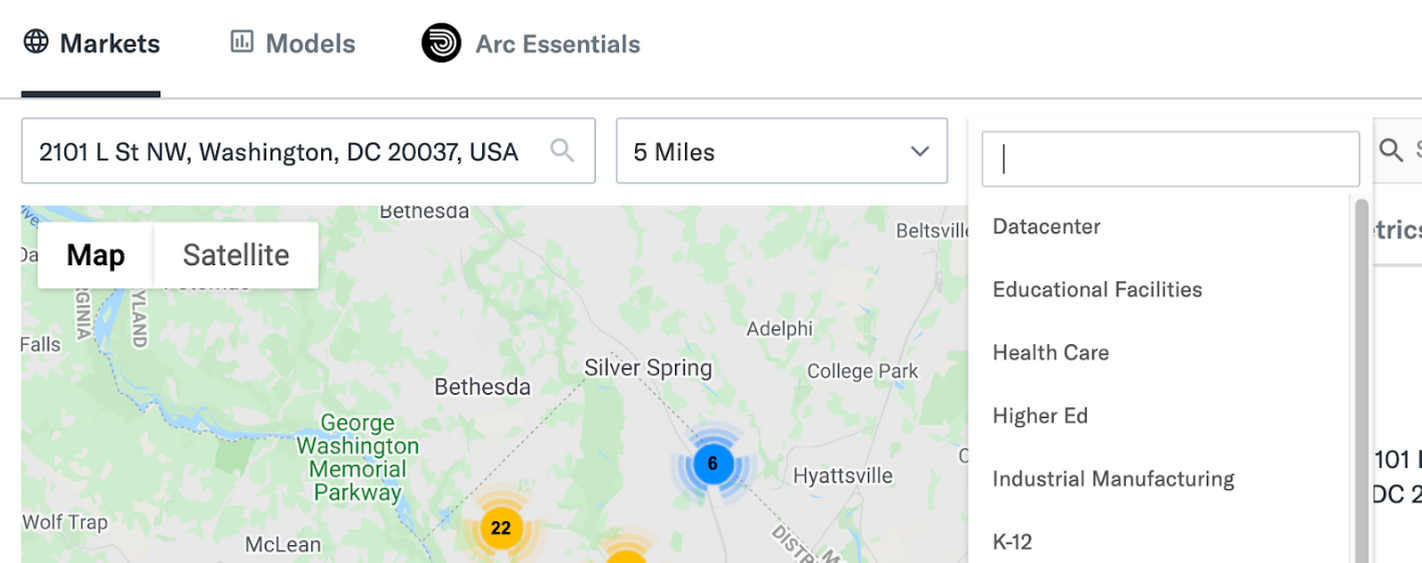
Arc Insight is a unique set of tools available to Arc Essentials subscribers. Arc Insight allows users to explore energy, water, and waste design goals for LEED Building Design & Construction (BD&C) projects around the world. This helps project teams understand prevailing practices and plan for leadership.
Our most recent release includes a new geocoding system. This unlocks new capabilities for projects across the United States and around the world:
- Search for an address or place name anywhere in the world;
- Refine the search by geographic distance or property type; and
- Create and export a summary report with information about LEED credit achievement and zEPI scores.
How can I access Arc Insight?
Arc Insight is available to Arc Essentials subscribers. Login and select “Insight” from the top navigation.

Learn more about Arc Essentials.
What is included in an Arc Insight report?
Working with Arc Insight usually starts with a location. The new features allow users to specify any address or geographic location (e.g., place name). Then, the user selects a distance and, optionally, refine the project type (e.g., office, public assembly, education, etc.). Users can select one or more project types from the drop down menu.

For example, a user can search for 2101 L Street, NW, Washington, DC with a radius of 5 miles. This returns 266 LEED BD&C projects. The user can review the results, toggling between projects, metrics, and strategies. Alternatively, the user can download all the information in a PDF report by selecting the Export button.
The result is shown in this sample report.

What is a zEPI score?
Arc Insight translates LEED credit achievement into a 0-to-100 index called a zEPI score. The zEPI score indicates progress toward net zero energy operations. Performance is compared to U.S. building stock as represented by the 2003 Commercial Building Energy Consumption Survey (CBECS) data.
According to the New Buildings Institute,
“The basis for zEPI can be traced back to a scale presented in a paper written by Charles Eley, an energy efficiency advocate and NBI Fellow, called “Rethinking Percent Savings.” Eley makes the compelling case for the adoption of a more stable, absolute scale that would be used to benchmark buildings as opposed to the typical percent-better-than-code metric. Code baselines are continuously shifting as more stringent rules are developed and adopted, making all previous percentages better-than-code meaningless. The scale establishes zero net energy as the absolute goal making the need for a baseline obsolete. The only measurement that matters is how far a building has progressed towards zero net energy performance. The scale goes from zero to 100, with 100 representing the average energy consumption based on 2003 Commercial Buildings Energy Consumption Survey (CBECS) data.”
Arc Insight provides graphics to illustrate variation in zEPI design goals among LEED projects. Project teams can consider opportunities to meet and, ideally, beat prevailing practices in the market.
Arc estimates the zEPI score by interpreting LEED Energy & Atmosphere Credit 1 achievement. Rating system version, point achievement, and climate zone are considered when estimating the project’s performance relative to the CBECS baseline.

How do I get started?
Arc Insight is a tool to understand markets and plan for leadership. Get started in three steps:
- Login to Arc using USGBC.org or LEEDOnline credentials.
- Upgrade to Arc Essentials. You can pay month-to-month or once per year.
- Select Insight, enter a location, and explore!
The Arc team welcomes the opportunity to provide more information. Please reach out to us contact@arcskoru.com
